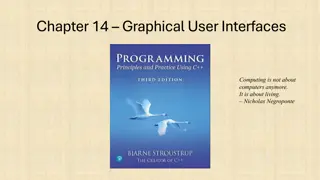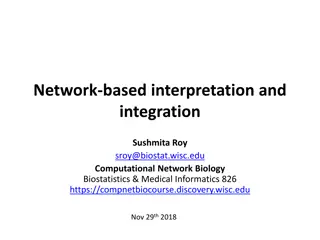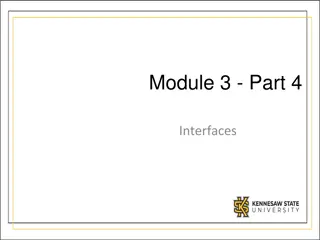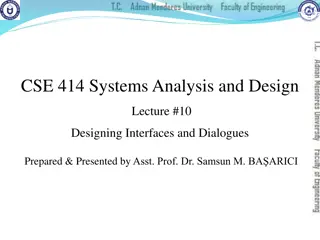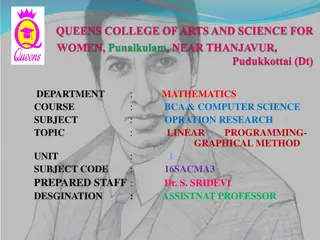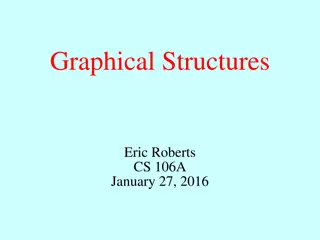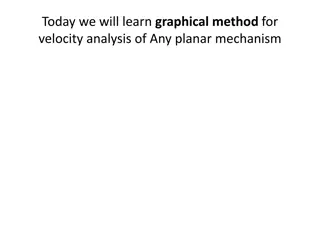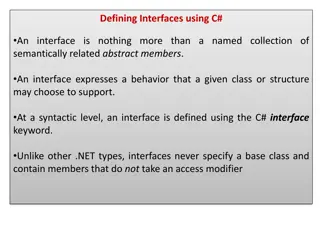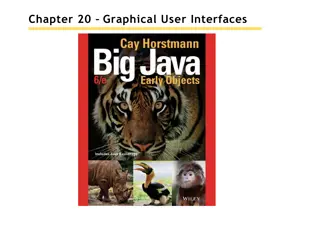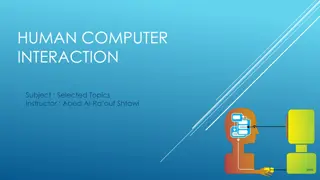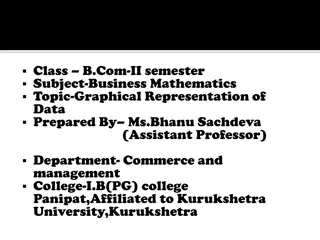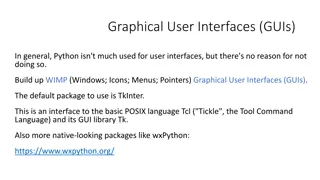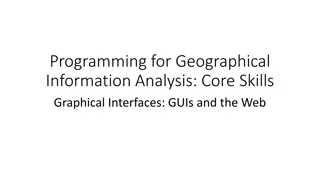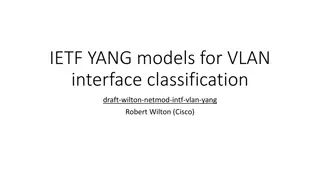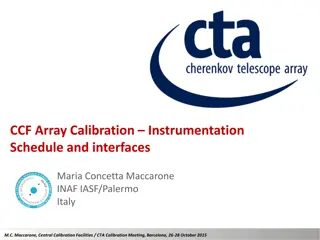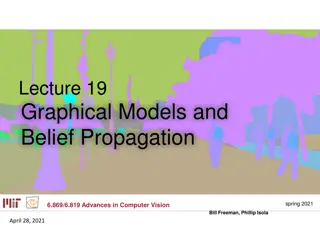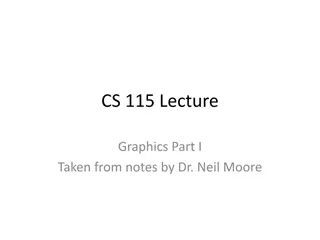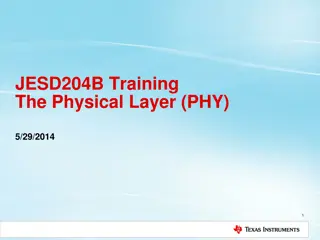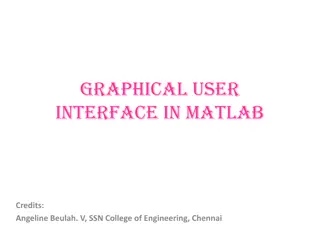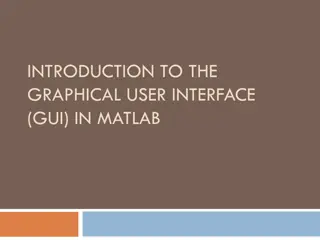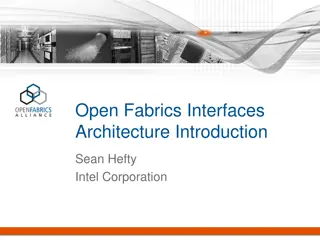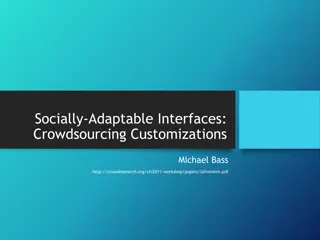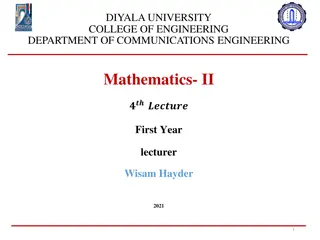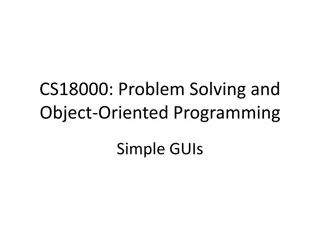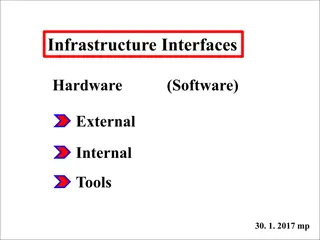Graphical representations of linear relationships
This material includes a series of checkpoint activities and additional tasks related to graphical representations of linear relationships for Year 8 students. Students will engage in tasks such as plotting points on coordinate grids, analyzing ant movements, exploring different rules for plotting p
1 views • 51 slides
The Evolution of Graphical User Interfaces in Computing
Graphical User Interfaces (GUIs) have transformed computing into a more user-friendly and interactive experience, emphasizing the shift from technology-focused to human-centric living. This chapter delves into the various aspects of GUIs, including I/O alternatives, common GUI tasks, programming per
1 views • 32 slides
Understanding Network Perturbations in Computational Biology
Network-based interpretation and integration play a crucial role in understanding genetic perturbations in biological systems. Perturbations in networks can affect nodes or edges, leading to valuable insights into gene function and phenotypic outcomes. Various algorithms, such as graph diffusion and
0 views • 55 slides
Understanding Java Interfaces in Amity School of Engineering & Technology
Java interfaces are a key concept in object-oriented programming that allows for achieving multiple inheritance. The article discusses how Java interfaces work, their role in defining class behavior, and the differences between interfaces and classes. It also explains the syntax for declaring interf
1 views • 48 slides
Understanding Interfaces in Object-Oriented Programming
Interfaces in OOP provide a way for unrelated classes to share common methods without implementation details. They serve as a set of requirements that must be implemented by classes. By creating interfaces, we can enforce standards and avoid issues like the "Diamond of Death" problem that arises fro
1 views • 17 slides
Designing Interfaces and Dialogues in Systems Analysis and Design
This lecture focuses on the process of designing interfaces and dialogues in systems, discussing methods for interacting with a system, designing human-computer dialogues, and creating graphical user interfaces. It covers guidelines for layout design, structuring data entry fields, providing feedbac
3 views • 62 slides
The Joy of Sets: Graphical Alternatives to Euler and Venn Diagrams
Graphical representations of set membership can be effectively portrayed using alternatives to traditional Euler and Venn diagrams. Learn about upset plots, indicating set membership graphically, and the use of Venn or Euler diagrams as solutions. Explore the historical context and challenges with V
2 views • 43 slides
Understanding Interfaces in Physical Pharmacy
Interfaces play a crucial role in physical pharmacy, dividing phases like solid, liquid, and gas. Liquid interfaces involve surface tension due to cohesive and adhesive forces. This chapter explores the classification and properties of interfaces, shedding light on the behavior of molecules at the b
0 views • 66 slides
Understanding Roots of Equations in Engineering: Methods and Techniques
Roots of equations are values of x where f(x) = 0. This chapter explores various techniques to find roots, such as graphical methods, bisection method, false position method, fixed-point iteration, Newton-Raphson method, and secant method. Graphical techniques provide rough estimates, while numerica
0 views • 13 slides
Understanding Interfaces and Abstract Classes in Java
Interfaces and abstract classes play a crucial role in Java programming by defining contracts and blueprints for classes to implement. Interfaces provide a way for classes to declare their capabilities, while abstract classes allow for partial implementation. This article explains the concepts of in
1 views • 19 slides
Linear Programming - Graphical Method in Operations Research
This presentation explores the application of linear programming using the graphical method in the field of Operations Research. Dr. S. Sridevi, Assistant Professor, delves into the concepts and techniques involved in solving optimization problems through graphical representations. The slides cover
0 views • 24 slides
Strategies for Effective Data Visualization
This talk by Nicholas J. Cox explores strategies to enhance data visualization for better interpretation and comparison. From spaghetti plots to front-and-back plots, various techniques are discussed to improve the clarity and effectiveness of graphical presentations. The presentation emphasizes the
1 views • 47 slides
Understanding GPolygon Class in Graphical Structures
The GPolygon class in graphical structures is utilized to represent graphical objects bounded by line segments, such as polygons. This class allows for the creation of polygons with vertices connected by edges, utilizing methods like addVertex and addEdge to construct the shape. The reference point
0 views • 26 slides
Graphical Method for Velocity Analysis of Planar Mechanisms
Learn about the graphical method for velocity analysis of planar mechanisms through practice problems involving slider-crank mechanisms and link velocities. Understand how to calculate slider velocity, point velocity, and angular velocities using the given dimensions and rotational speeds. Visualize
0 views • 6 slides
Understanding Interfaces in C#
Interfaces in C# define behavior that classes or structures can choose to support. They contain abstract members and do not specify a base class. Interfaces must be implemented by classes to bring functionality. Learn how to define and implement interfaces in C# to create flexible and modular code s
1 views • 22 slides
Understanding Graphical User Interfaces in Java
Learn about designing graphical user interfaces in Java, including layout management, common components like radio buttons and menus, browsing Java documentation effectively, and utilizing inheritance for complex frames. Explore topics such as using layout managers to organize UI components, creatin
0 views • 74 slides
Addressing User Credentials and Security in CCSDS Service Interfaces
The discussion revolves around the need to define user credentials within CCSDS service interfaces for enhanced security. Various aspects such as the lack of specific specifications, authentication requirements, and proposed actions for securing service interfaces are highlighted. Suggestions includ
0 views • 11 slides
Overview of EGI Online Storage Service Architecture and Interfaces
EGI Online Storage service provided by EOSC-hub under Horizon 2020 program offers File Storage, Block Storage, and Object Storage options. Users can access highly scalable storage with different interfaces. The service allows data access through standard protocols, fault tolerance replication, globa
0 views • 18 slides
Understanding Java Swing for Building Graphical User Interfaces
Java Swing is a powerful framework for creating graphical user interface applications in Java. It provides a wide array of visual components such as JFrame, JComponent, and JPanel, enabling developers to build interactive and visually appealing applications easily. With Swing, developers can design
1 views • 25 slides
Exploring Graphical User Interfaces (GUIs) and JOptionPane in Java
Introduction to Object-Oriented Programming (OOP) and GUI concepts in Java, focusing on GUI hierarchy, designing GUIs, working with containers and components, utilizing JOptionPane for graphical input/output, and examples of showMessageDialog and showConfirmDialog in Java applications.
0 views • 90 slides
Database Deployment Automation for IMS Interfaces
Automate your database deployments for IMS interfaces within the scope of various systems and interfaces including Wells Fargo, SUNTAX, transport scanners, KODAK, Fujitsu, FDLE, CAMS, DBPR, and more. This includes interfaces to GTA, CAMS, Wells Fargo, Florida Department of Law Enforcement (FDLE), an
0 views • 9 slides
Enhancing and Testing Repository Deposit Interfaces
Talk by Steve Hitchcock at Open Repositories Conference on enhancing and testing repository deposit interfaces, focusing on open access Institutional Repositories, user value, new deposit interfaces, testing results with SWORDv2, and boosting deposit rates. Credits and acknowledgements for the proje
0 views • 23 slides
Understanding Human-Computer Interaction: CLI vs. GUI
Explore the evolution of Human-Computer Interaction (HCI) from its history to the advent of Command Line Interfaces (CLI) and Graphical User Interfaces (GUI). Learn about the advantages, disadvantages, applications, and how CLI and GUI differ in user interaction paradigms.
0 views • 19 slides
Insights into Graphical Representation of Data in Business Mathematics
Graphical representation of data in Business Mathematics is a powerful tool that provides a bird's eye view of statistical information. It enables easy visualization of variations in variables, aiding in understanding time series and frequency distributions efficiently. While graphs offer quick esti
0 views • 18 slides
Python GUI Development: Creating User-Friendly Interfaces
Python can be effectively used for creating Graphical User Interfaces (GUIs) by leveraging libraries like Tkinter and wxPython. This guide covers GUI design principles, event-based programming, and tips for enhancing the user experience. It emphasizes the importance of designing intuitive interfaces
0 views • 6 slides
Introduction to Graphical User Interfaces (GUIs) in Python for Geographical Information Analysis
This content provides insights into creating Graphical User Interfaces (GUIs) in Python for Geographical Information Analysis. It covers the basics of GUI development using TkInter and event-based programming with a focus on user experience design and functionality. The lecture emphasizes the import
0 views • 45 slides
Understanding Interfaces and Classes in Java
Explore the concept of interfaces and classes in Java programming. Learn about defining methods in interfaces, implementing interfaces in classes, and the relationship between classes and interfaces. Discover how interfaces can be used to define a common set of methods that classes must implement, l
0 views • 25 slides
Understanding VLAN Interface Classification in IETF YANG Models
This content delves into the concept of interfaces in networking, focusing on child interfaces. It explains the need for child interfaces to apply separate feature and forwarding rules to specific traffic subsets. The discussion covers the characteristics of interfaces, the hierarchy of child interf
0 views • 10 slides
Array Calibration Instrumentation Interfaces and Schedule by Maria Concetta Maccarone at CTA Calibration Meeting
Maria Concetta Maccarone from INAF IASF/Palermo presented on the instrumentation interfaces and schedule for array calibration within the CCF project at the CTA Calibration Meeting in Barcelona. The presentation discussed major interfaces within the CTA instrument, methods for calibration, and the i
0 views • 6 slides
Graphical Models and Belief Propagation in Computer Vision
Identical local evidence can lead to different interpretations in computer vision, highlighting the importance of propagating information effectively. Probabilistic graphical models serve as a powerful tool for this purpose, enabling the propagation of local information within an image. This lecture
0 views • 50 slides
Understanding Interfaces and Abstract Classes in CS/ENGRD 2110 Spring 2016
Explore the concepts of interfaces and abstract classes in the context of computer science with a detailed examination of their characteristics, implementations, and extensions. Learn how classes implement interfaces, utilize interface methods, and extend other interfaces to enhance functionality in
0 views • 11 slides
Exploring the Graphics Library for Enhanced User Interaction in Python
Explore the Zelle graphics library in Python for creating interactive graphical user interfaces. Learn about classes like GraphWin, Point, Line, Circle, Rectangle, Oval, Polygon, Text, Entry, and Image to enhance the visual appeal of your programs and engage users in a more intuitive manner. Utilize
0 views • 25 slides
Understanding JESD204B Physical Layer (PHY) in High-Speed Serial Interfaces
The JESD204B training presentation delves into the Physical Layer (PHY) of high-speed serial interfaces, covering topics such as speed grades, compliance types, SERDES solutions for long channels, clocking information, differential link data transmission, and electrical requirements for drivers and
0 views • 20 slides
Introduction to Creating Graphical User Interfaces in MATLAB
Explore the world of creating Graphical User Interfaces (GUIs) in MATLAB with this informative guide. Learn how to design GUIs, program them to respond to user actions, and launch them effortlessly. Dive into essential topics such as GUI creation, component layout, and programming details, all witho
0 views • 40 slides
Introduction to Graphical User Interface (GUI) in MATLAB
A graphical user interface (GUI) allows users to interact with software using visual elements like menus, buttons, and icons, instead of text-based commands. In MATLAB, GUIs consist of two main files - an .m file for code and a .fig file for graphical elements. GUIs enable users to interact with MAT
0 views • 50 slides
Evolution of OpenFabrics Interfaces Architecture
Evolution of OpenFabrics Interfaces Architecture aims to align software interfaces with application requirements in the realm of high-performance computing (HPC). With a focus on supporting multiple interface semantics, remaining fabric and vendor agnostic, and adaptable in upstream Linux, the initi
0 views • 42 slides
Revolutionizing Interfaces through Social Adaptability and Crowdsourcing
Explore the innovative concept of socially-adaptable interfaces and crowdsourcing in interface design, allowing users to customize and share task sets for improved functionality and productivity. Learn about traditional vs. adaptable interfaces, the role of crowdsourcing in enhancing user experience
0 views • 7 slides
Graphical Solutions of Autonomous Equations in Mathematics II
Explore the graphical solutions of autonomous equations in Mathematics II taught by lecturer Wisam Hayder at Diyala University's College of Engineering. Learn about phase lines, equilibrium values, construction of graphical solutions, and sketching solution curves using phase lines. Dive into exampl
0 views • 34 slides
Working with Java GUI Components in Object-Oriented Programming
Explore the fundamentals of creating simple Graphical User Interfaces (GUIs) in Java through the use of components like JOptionPane and dialogs. Understand the transition from text-based interfaces to GUIs, learn about dialog concepts, and discover how to utilize JOptionPane class for interactive mo
0 views • 37 slides
Enhancing Infrastructure Interfaces for Telescope Operations
In the realm of telescope operations, ensuring clear interfaces is crucial for smooth functioning. This involves addressing ill-defined interfaces, database management, locating interfaces, internal and external interface specifications, and tool requirements without the need for adaptations. By foc
0 views • 13 slides

